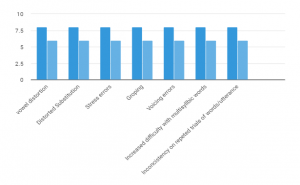
Online Speech Therapy for Autism with Apraxia of Speech – Case study
Online Speech Therapy on Autism with Apraxia of Speech – Case study
The Case Study: Effect of Online Speech Therapy on a Child with Autism & Apraxia of Speech. Autism Spectrum Disorder (ASD) is a multifaceted condition. It becomes evident around the age of three, encompassing various challenges related to communication skills. The poor social skills, sensory integration difficulties, and speech and language problems encompass the typical behavioral signs (Dimitrova.M 2019)
Apraxia of speech is a neurological disorder. It’s affecting the brain’s pathways involved in planning the sequential movements required for speech production. This condition leads to distorted sounds and inconsistent errors in speech, including variations in tone, stress, and rhythm.
Apraxia of Speech and Autism
A recent study conducted at Penn State Milton and Hershey Medical Center frequently observes apraxia in individuals with Autism Spectrum Disorder (ASD). The findings published in the Journal of Developmental and Behavioral Pediatrics indicated that around 63.6 percent (almost two-thirds) of children are diagnosed with autism. It also exhibited signs of apraxia. Several conceptual and empirical perspectives provide support for the notion that apraxia might play a role in the lack of speech development observed in individuals with ASD.
The Journal of Developmental and Behavioral Pediatrics reported that approximately 63.6 percent (nearly two-thirds) of children diagnosed with autism also displayed symptoms of apraxia. Various conceptual and empirical perspectives support the hypothesis that apraxia may contribute to the absence of speech development in individuals with ASD. Children with ASD often exhibit deficits in praxis, particularly in imitative processes, which can affect their ability to acquire and perform motor commands. These findings suggest that a deficit in praxis, specifically in speech, could be a potential factor contributing to speech difficulties in individuals with ASD. The neurobehavioral substrates of apraxia could explain the speech and prosody-related challenges observed in ASD.
Speech-Language Pathologists (SLPs) estimate that approximately one in six children with ASD on their caseloads may have Childhood Apraxia of Speech (CAS) (Dawson, 2010). The aim of this study was to document and analyze the intervention of tele-speech therapy for a child diagnosed with both Autism Spectrum Disorder and apraxia of speech. This report provides a clinical overview of the client’s rehabilitation journey through tele-practice.
Clinical overview of our client’s rehabilitation journey.
Method
Participant
For this study, we considered a 5-year-old female child diagnosed with autism spectrum disorder with apraxia of speech. The parents of the child provided written consent for this study. The parents reported speech and language development delays and attended speech therapy in their hometown in the past.
Method
We assessed the participant using the Childhood Apraxia of Speech (CAS) clinical assessment worksheet and the Receptive Expressive Emergent Language Test (REELS). The test result of the childhood apraxia of speech(CAS) clinical assessment worksheet reveals child has vowel distortions, the distorted substitution of speech sounds, stress errors, groping moments, voicing errors, Increased difficulty with multi-syllabic words, and Inconsistency on repeated trials of words/utterances.
- Receptive Expressive Emergent Language Test (REELS)
- Results reveal
- Receptive language age-3.5 to 4yrs
- Expressive language age- 12 to 14 months
We diagnosed the individual with autism spectrum disorder accompanied by apraxia of speech. We observed significant difficulties in speech and language across various tasks, including speaking, reading, monologue, and conversation. After completing the evaluation and testing process, we recommended the participant receive speech therapy.
The participant opted to engage in speech and language therapy sessions five days a week, with each session lasting 45 minutes. The therapy spanned a period of five months, from January 2023 to May 2023. We conducted assessments and treatment sessions remotely through tele-practice, utilizing the Zoom video-conferencing software. The clinician used a Dell intel core i5 laptop with 300mbps and an in-built camera with an external microphone and speaker. The participant used an Acer laptop with 300mbps internet speed with an in-built camera and microphone.
During the treatment session, we followed speech and language facilitating techniques. We incorporated strategies such as speech drills, sound and movement exercises, speaking practices, vowel practice, and paced learning.
Recorded video and audio during the first assessment session and on the last day of the post-evaluation therapy session to note progress.
We regularly evaluated the participant’s speech and language skills every two months and documented the progress.
Results
A pre-therapy and post-therapy score assessment was done to determine progress. The Childhood apraxia of speech(CAS) clinical assessment worksheet and Receptive Expressive Emergent Language Test (REELS) were re-assessed at the end of five months of intensive speech and language therapy.
Graph 1 shows the pre-therapy and post-therapy scores on the Childhood apraxia of speech(CAS) clinical assessment worksheet
Graph 1: Pre and Post Therapy test results of vowel distortions, the distorted substitution of speech sounds, stress errors, groping moments, voicing errors, Increased difficulty with
multi-syllabic words and Inconsistency on repeated trials of words/utterances
- Receptive Expressive Emergent Language Test (REELS)
- Results reveal
- Receptive language age-3.5 to 4yrs
- Expressive language age- 16 to 18 months
Results showed a significant improvement in the participant’s overall speech and language skills.
Discussion and Conclusion
Autism spectrum disorder (ASD) is a neurodevelopmental disorder characterized by deficits in social communication and social interaction and restricted repetitive behaviors. Childhood Apraxia of speech is a type of SSD that impacts the ability to effectively plan and program speech movements (ASHA, 2007) Autism Spectrum Disorder (ASD) and Childhood Apraxia of Speech (CAS) are developmental disorders with distinct diagnostic criteria and different epidemiology. However, a common genetic background as well as overlapping clinical features between ASD and CAS have been recently reported. Speech and language features include Inconsistent errors with consonants and vowels when pronouncing syllables and words. Difficulty moving from sound to sound and syllable to syllable. This tends to result in rather long pauses between sounds and syllables.
Unusual emphasis on parts of speech. For example, a child may pronounce all the syllables in a word or sentence with equal stress.
The purpose of the current study was to describe the effect of teletherapy/online speech therapy on a child with Autism Spectrum disorder with apraxia of speech. The results of the present study indicate positive progress in the overall speech and language development of the participant conducted via tele practice.
Read more on: Click here
- The Differences Between ADHD and Autism - June 6, 2023
- Online Speech Therapy for Autism with Apraxia of Speech – Case study - June 2, 2023


Leave a Comment
(2 Comments)
Can you test for Apraxia if the child does not speak?
When assessing a child for apraxia who does not speak, a comprehensive evaluation is necessary to gather information about their overall communication abilities and motor skills.
Categories
Recent Posts